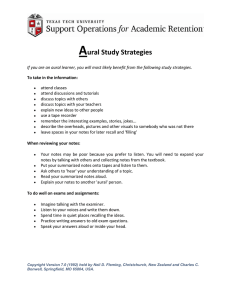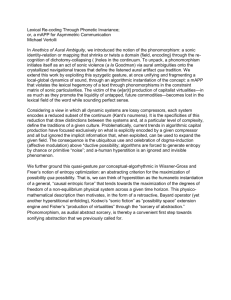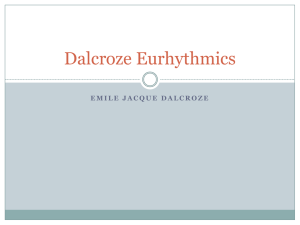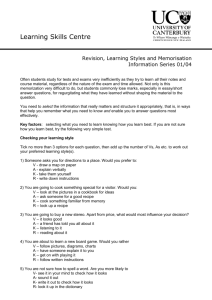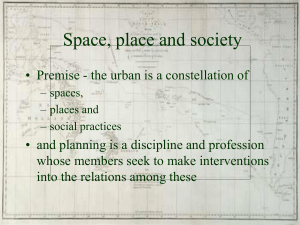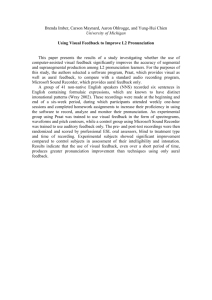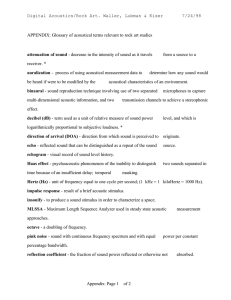Working Vocabulary for the Experience of Aural Architecture www.Blesser.net\downloads\Glossary.pdf
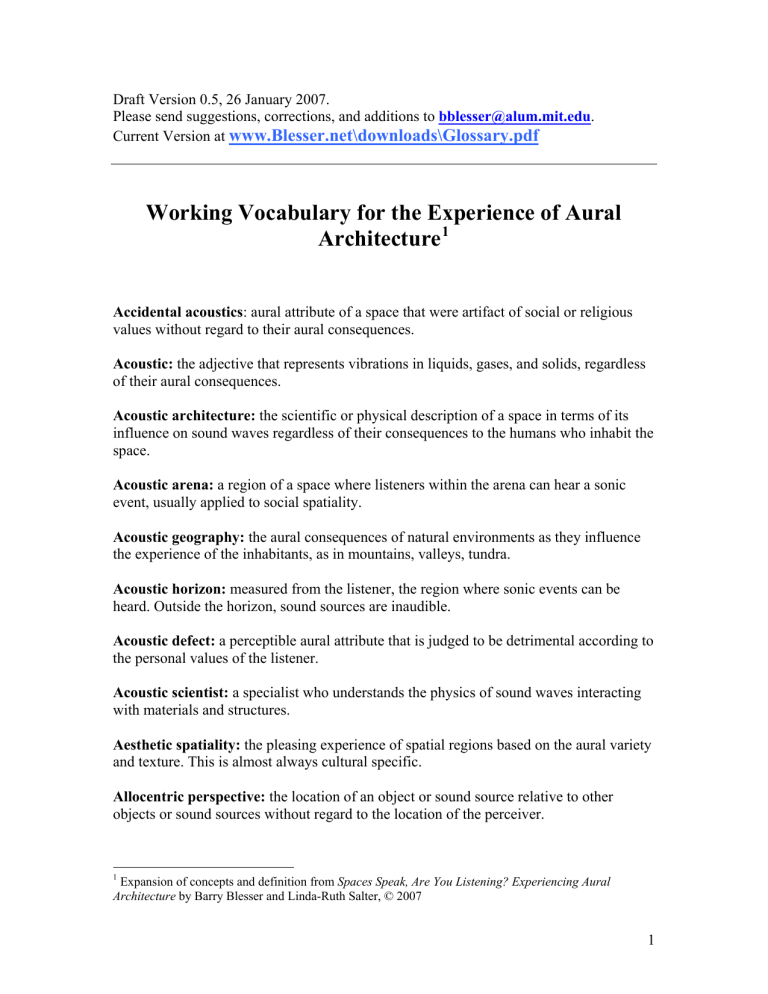
Draft Version 0.5, 26 January 2007.
Please send suggestions, corrections, and additions to bblesser@alum.mit.edu
.
Current Version at
www.Blesser.net\downloads\Glossary.pdf
Working Vocabulary for the Experience of Aural
Architecture
Accidental acoustics : aural attribute of a space that were artifact of social or religious values without regard to their aural consequences.
Acoustic: the adjective that represents vibrations in liquids, gases, and solids, regardless of their aural consequences.
Acoustic architecture: the scientific or physical description of a space in terms of its influence on sound waves regardless of their consequences to the humans who inhabit the space.
Acoustic arena: a region of a space where listeners within the arena can hear a sonic event, usually applied to social spatiality.
Acoustic geography: the aural consequences of natural environments as they influence the experience of the inhabitants, as in mountains, valleys, tundra.
Acoustic horizon: measured from the listener, the region where sonic events can be heard. Outside the horizon, sound sources are inaudible.
Acoustic defect: a perceptible aural attribute that is judged to be detrimental according to the personal values of the listener.
Acoustic scientist: a specialist who understands the physics of sound waves interacting with materials and structures.
Aesthetic spatiality: the pleasing experience of spatial regions based on the aural variety and texture. This is almost always cultural specific.
Allocentric perspective: the location of an object or sound source relative to other objects or sound sources without regard to the location of the perceiver.
1
Expansion of concepts and definition from Spaces Speak, Are You Listening? Experiencing Aural
Architecture by Barry Blesser and Linda-Ruth Salter, © 2007
1
Aural: the adjective that focuses on the listener’s experience of sound using a natural social science language, which is the parallel of visual impressions for a painter.
Aural adjectives: words that are used to describe aspects of a sound, but mostly these are
(a) borrowed from other senses such as vision, (b) are ambiguous and originate form the culture or sub-culture, or (c) are nothing more than aliases for the event that caused them.
Auralization: an ambiguous concept that means either (a) the simulation of a space such that listeners can experience what the space would sound like, or (b) the human ability to create in internal image of a space by listening, parallel to visualization
Aural size: the perceived size of the sound source, called apparent-source-width in the scientific literature. Perceived size can be increased with strong early reflections.
Aural architect: a person who selects those attributes of spatiality that suit the purpose of the space.
Aural architecture: a natural or man-made structure or environment that can be experienced in terms of one or more attributes of spatiality.
Awareness: a listener is said to be aware of an aural attribute if it changes his body state without necessarily being able to consciously perceive or describe the experience.
Casual listening: one of three mode of listening where the perceiver is only getting a sense that the sound exists and the nature of the sonic event that created it.
Close microphones : recording or capturing a sound without any influence from the spatial acoustics by placing the microphone very close to the source, equivalent to an anechoic environment.
Cognitive load: the mental and emotion burden requires for the listener to achieve the goal of perceiving or interpreting an aural situation.
Cognitive map: the internal construction of a space without being consistent with the actual space.
Cognitive strategies: the human rules and algorithms for assigning meaning to sound attributes. There are many choices for such strategies, and a listener can switch strategies at will.
Coloration: An emphasis or de-emphasis of a particular frequency region such that the spectrum is changed relative to the source. Implies that the spectral change is perceptible.
Cross-model plasticity: the ability of sound to influence vision, and vice versa.
2
Cultural acoustics: that aspect of an aural experience that cannot be understood by analyzing the physical properties of the sound or space.
Desirable attribute: an aural component that is evaluated using the personal values of the individual. Such attributes must also be detectable and perceptible.
Detecting sound: the ability to know that a sound is present regardless of its meaning, cultural use, or information content. Also, detectable attribute.
Direct sound: that sound that travels directly from the source to the listener as distinct from reflections that will appear delayed.
Discriminating sound: the ability to know that two sounds are different.
Dry acoustics: a space that contributes a minimal amount of reverberation or resonances to the experience of the space.
Earcon: A unique sound that acquires symbolic meaning through social and cultural associations, the aural parallel of icon. Symbolic meaning is often linked to religious or spiritual experiences.
Echo: a sound that appears a second time delayed relative to the first such that the second sound is experiences as a recognizable duplication. A short delay produces coloration and is not necessarily perceived as an echo. Echoes typically appear from reflections from surfaces, but reflections are not necessarily perceived as echoes.
Echoic memory: a rare ability of some individuals to remember a sound exactly as if replaying it with a tape recorder. Parallel to eidetic memory.
Echolocation: now used generically without regard to echoes to mean the perception of passive objects in geometries, equivalent to seeing with ears. Historically, called face vision.
Egocentric perspective: referencing a object or sound location relative to the perceiver.
Some cultures use this as their primary means of describing location
Enveloping reverberation: the experience of being immersed in reverberation.
Experience originates primarily from the intensity of the late lateral reflections.
Epistemology: the philosophic study of how we know what we know and when an assertion contributes to answering a particular question. Without a clear understanding of assumptions, an assertion cannot be interpreted.
Ergodic space: a mathematical concept in statistical acoustics where the space has reached steady state such that the statistics over time at a single location are the same as
3
the statistics of all locations at a single time. No space achieves this ideal, and few spaces even approximate the ideal.
Experience independent learning : acquiring a skill without requiring exposure to sounds, mostly neurological development.
Experience dependent learning: acquiring a skill after extensive practice and exposure, as in ear training.
Experience expectant learning: acquiring a skill in a particular developmental stage where the brain expects to be exposed to a rich environment from which it can learng.
Experiencing sound: the result of sound producing a meaningful change in the listener’s state by influencing mood or emotion. Such sounds have personal significance to the listener.
Expert perceivers: those with special perceptual skills to reliably detect and use aural attributes that are unavailable to most people, often call golden-ears.
Folk science: the use of perceptual experts to investigate a phenomenon where it may not be possible to use the formal methods of science. Science may not have a paradigm to answer a question. Often relies on inference, speculation, personal testimonials, and observable demonstrations.
Functional deafness: the inability to hear events in the immediate environment as if deaf to the actual space, often created by excessively loud sound and/or headphones.
Hot spot: A region of a space where an aural experience is particularly intense, as for example at a resonance.
Intent of use: a space or object, built or selected, on the basis of how it would be used by the inhabitants, as for example, a religious ceremonial, political, or religious space. Intent of use may not imply an acoustic design.
Intent of design: the selection or creation of those physical attributes which can produce an explicit or implicit set of aural properties, as for example, the intent to create long running reverberance.
Local acoustics: spatial attributes that can only be experiences in a small region of the space.
Limbic system: those parts of the brain that process the “emotional” attributes of stimuli.
It is a general concept without specifying a particular substrate. All meaningful experiences involve some aspect of the limbic system.
4
Mixing time: a statistic concept for enclosed spaces where all information about the source of sound has been fully lost, weaker than an ergodic space.
Meta-instruments: concept of a musical instrument that includes the spatial acoustics and spatial resonances.
Musical spatiality: the experience of real or virtual spaces when illuminated with music and experienced in terms of the way that the space influence the experience of music.
Navigational spatiality: the auditory experience of a space for the purpose of orienting and navigating by recognizing passive objects and spatial geometry.
Perceiving sound: the translation of sound using cultural conventions that allow sound to be decoded into higher level tokens, but not necessarily with important meaning. One can perceive random tones as a sequence. Also, perceptible attribute.
Perceptual boundaries: a spatial region that is experience as distinct from other regions, but which depends on the sense modality. A boundary need not have a physical separator.
Phenomenology: the study of a phenomenon by considering it as a holistic unity without segregating questions into disciplines.
Reduced listening: one of three listening modes where the perceiver is intensely focusing on the sound itself without regard to meaning, content, location, or event.
Reverberation: the experience of multiple reflections that are not perceived individually.
Typically enclosed spaces of sufficient size produce reverberation, which is characterized by an enveloping sound not being localizable.
Running reverberance: the experience of reverberation when the source continues to emit sound. Only the early part of the reverberation process contributes to running reverberance.
Semantic listening: one of three modes of listening where the perceiver is extracting information from the sound, as in speech or music.
Social spatiality: the way in which the aural attributes of a space influence the social relationships and social cohesion of the inhabitants of a space.
Sonic event: a man-made or natural dynamic action that produces sound. Listeners may use sound as the means of connecting to the event.
Sonic illumination: sounds that provide the means by which the passive objects and geometries of a space can be experiences by how they respond to the illumination, parallels visual illumination (light).
5
Sonic illumination: Sound that is considered primarily as illuminating a structure so that it can be perceived apart from the sound source.
Sound: the vibrations in air or solids, primarily in the audible region of frequency and amplitude. Sound is entirely a physical concept.
Sound location: the perceived position of source in a real or virtual world.
Soundscape: Inseparable holistic experience of sound sources and spatial acoustics.
Sound source: The origin of sound, primarily from a transduction that converts mechanical energy into air vibration.
Spatial spreading: one of the two dimensions of musical spatiality, spreading the sense of location from a point to envelopment.
Spatiality: the human auditory experience of a real or virtual space.
Spectral flutter: a non-uniform or periodic reverberation decay that results from the interaction of spatial acoustics and the spectrum of a sound of extended duration.
Stopped reverberance: the perception of the reverberation tail when the source as stopping creating noise.
Sweet spot: the area of a space whose sound field is particular optimum for the desired experience of the listeners. Outside of the sweet spot the experience is weaker.
Symbolic spatiality: those aural spatial attributes that acquire special meaning by association with other human activities, such as religion or spirituality. They acquire earconic meaning in the broader sense than that used with computers.
Temporal flutter: a non-uniform or periodic envelope in the reverberation decay that results from the space’s response to a short impulse like sound.
Temporal spreading: one of the two attributes of musical spatiality, spreading a short sonic event into one that continues for an extended time, see running reverberance.
Virtual space: the experience of spatiality where an actually space may not, or could not, have existed.
Wet space: a space that contributes a large amount of reverberation or resonances.
Opposite of dry.
6
